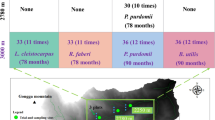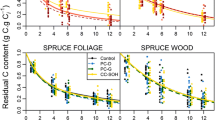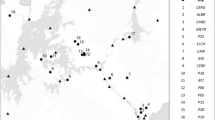Abstract
We synthesized available data for decomposition of pine (Pinus) needle litter in pine forests to determine the litter chemical characteristics and climate factors that explained variation in the limit value, i.e. the level of accumulated mass loss at which the decomposition process either continues at a very low rate or possibly stops. Our data base included 56 separate studies on decomposition of pine needle litter, spanning Scots pine, lodgepole pine, Aleppo pine, stone pine and white pine, mainly incubated at the site of collection. Studies had 5 to 19 samplings, on average 10, and the decomposition was followed to a mass loss ranging from 47 to 83%, on average 67%. The periods from 3.0 to 5.4 years, on average 3.9 years, were of sufficient duration to allow estimates of limit values of decomposition. We used a linear mixed model with regression effects to relate limit values to potential explanatory variables, namely the sites’ long-term mean annual temperature (MAT) and mean annual precipitation (MAP) and to substrate-chemistry factors. Regarding the latter, we explored two models; one that included initial concentrations of water solubles, lignin, N, P, K, Ca, Mg, and Mn and one that included only lignin, N, Ca, and Mn to focus on those nutrients known to influence lignin degradation. Using backward elimination significant explanatory variables were determined. For litter decomposed in its site of origin we found the limit value to depend mainly on the initial concentration of Mn, with higher Mn concentrations resulting in higher accumulated mass loss. Thus, litter with higher Mn reached a higher limit value and left a smaller stable fraction. This is likely due to the fact that Mn is an essential component of ligninolytic enzymes important for degrading litter in the later stages of decomposition. Manganese has received little attention in decomposition studies to date. Given its significance in this synthesis, the role of Mn in influencing variation in the late stages of decomposition among ecosystems and among litters of other genera besides Pinus deserves further attention.






Similar content being viewed by others
References
Berg B (1998) A maximum limit for foliar litter decomposition—a synthesis of data from forest systems. Reports from Departments of Forest Ecology and Forest Soils, Swedish University of Agricultural Sciences. Report 77, 158 pp
Berg B (2000a) Litter decomposition and organic matter turnover in northern forest soils. For Ecol Manage 133:13–22
Berg B (2000b) Initial rates and limit values for decomposition of Scots pine and Norway spruce needle litter—a synthesis for N-fertilized forest stands. Can J For Res 30:122–135
Berg B, Cortina J (1995) Nutrient dynamics in some leaf and needle litter types of different chemical composition in a Scots pine forest. Scand J For Res 10:1–11
Berg B, Dise N (2004) Validating a new model for N sequestration in forest soil organic matter. Water Air Soil Pollut Focus 4:343–358
Berg B, Ekbohm G (1991) Litter mass-loss rates and decomposition patterns in some needle and leaf litter types. Long-term decomposition in a Scots pine forest VII. Can J Bot 69:1449–1456
Berg B, Lundmark J-E (1985) Decomposition of needle and root litter in lodgepole pine and Scots pine monocultural systems. Research notes no. 53, Department of Forest Ecology and Forest Soils. Swedish University of Agricultural Sciences, Uppsala, 76 pp
Berg B, Lundmark JE (1987) Decomposition of needle litter in lodgepole pine and scots pine monocultures—a comparison. Scand J For Res 2:3–12
Berg B, McClaugherty C (2008) Plant litter. Decomposition. Humus formation. Carbon sequestration. Springer Verlag, Heidelberg, Berlin, p 338
Berg B, Meentemeyer V (2002) Litter quality in a north European transect versus carbon storage potential. Plant Soil 242:83–92
Berg B, Hannus K, Popoff T, Theander O (1982) Changes in organic-chemical components during decomposition. Long-term decomposition in a Scots pine forest I. Can J Bot 60:1310–1319
Berg B, Booltink HGW, Breymeyer A, Ewertsson A, Gallardo A, Holm B, Johansson M-B, Koivuoja S, Meentemeyer V, Nyman P, Olofsson J, Pettersson A-S, Reurslag A, Staaf H, Staaf I, Uba L (1991) Data on needle litter decomposition and soil climate as well as site characteristics for some coniferous forest sites, 2nd edn. Section 2. Data on needle litter decomposition. Report no. 42, Swedish University of Agricultural Sciences. Department of Ecology and Environmental Research
Berg B, Berg M, Bottner P, Box E, Breymeyer A, Calvo de Anta R, Couteaux M, Gallardo A, Escudero A, Kratz W, Madeira M, Mälkönen E, Meentemeyer V, Muñoz F, Piussi P, Remacle J, Virzo De Santo A (1993) Litter mass loss in pine forests of Europe and Eastern United States as compared to actual evapotranspiration on a European scale. Biogeochemistry 20:127–153
Berg B, Calvo de Anta R, Escudero A, Johansson M-B, Laskowski R, Madeira M, McClaugherty C, Meentemeyer V, Reurslag A, Virzo De Santo A (1995) The chemical composition of newly shed needle litter of different pine species and Scots pine in a climatic transect. Long-term decomposition in a Scots pine forest X. Can J Bot 73:1423–1435
Berg B, Ekbohm G, Johansson M-B, McClaugherty C, Rutigliano F, Virzo De Santo A (1996) Some foliar litter types have a maximum limit for decomposition—a synthesis of data from forest systems. Can J Bot 74:659–672
Berg B, Johansson M-B, Lundmark J-E (1997) Site descriptions for forest sites—a compilation. Report 73, Department for Forest Ecology and Forest Soils, Swedish University of Agricultural Sciences, 43 pp
Berg B, Laskowski R, Virzo De Santo A (1999) Estimated N concentration in humus as based on initial N concentration in foliar litter—a synthesis. Can J Bot 77:1712–1722
Berg B, Johansson M-B, Meentemeyer V (2000) Litter decomposition in a transect of Norway spruce forests: substrate quality and climate control of mass-loss rates. Can J For Res 30:1136–1147
Berg B, McClaugherty C, Virzo De Santo A, Johnson D (2001) Humus build-up in boreal forests-effects of litter fall and its N concentration. Can J For Res 31:988–998
Berg B, Steffen K, McClaugherty C (2007) Litter decomposition rates as dependent on litter Mn concentration. Biogeochemistry 85:29–39
Bethge PO, Rådeström R, Theander O (1971) Kvantitativ kolhydrat-bestämning—en detaljstudie. Communication from Swedish Forest Product Research Laboratory, 63B. Stockholm, 48 pp (In Swedish)
Carreiro MM, Sinsabaugh RL, Repert DA, Parkhurst DF (2000) Microbial enzyme shifts explain litter decay responses to simulated nitrogen deposition. Ecology 81:2359–2365
Couteaux M-M, McTiernan K, Berg B, Szuberla D, Dardennes P (1998) Chemical composition and carbon mineralisation potential of Scots pine needles at different stages of decomposition. Soil Biol Biochem 30:583–595
Davey M, Berg B, Emmett B, Rowland P (2007) Controls of foliar litter decomposition and implications for C sequestration in oak woodlands. Can J Bot 85:16–24
Effland MJ (1977) Modified procedure to determine acid insoluble lignin in wood and pulp. Tech Assoc Pulp Pap Ind J 60(10):143–144
Eriksson K-E, Blanchette RA, Ander P (1990) Microbial and enzymatic degradation of wood and wood components. Springer Series in Wood Science. Springer Verlag, Berlin
Faituri MY (2002) Soil organic matter in Mediterranean and Scandinavian forest ecosystems and dynamics of nutrients and monomeric phenolic compounds. Silvestra 236:1–136
Fogel R, Cromack K (1977) Effect of habitat and substrate quality on Douglas fir litter decomposition in western Oregon. Can J Bot 55:1632–1640
Graybill FA, Iyer HK (1994) Regression analysis: concepts and applications. Duxbury Press, Belmont
Hatakka A (1994) Lignin-modifying enzymes from selected white-rot fungi: production and role in lignin degradation. FEMS Microbiol Rev 13:125–135
Hatakka A (2001) Biodegradation of lignin. In: Hofrichter M, Steinbüchel A (eds) Lignin, humic substances and coal, vol 1. Wiley-VCH, Germany, pp 129–180
Hatakka A, Buswell JA, Pirhonen TI, Uusi-Rauva AK (1983) Degradation of 14C-labelled lignins by white-rot fungi. In: Higuchi T, Chang H, Kirk TK (eds) Recent advances in lignin biodegradation research. Uni Publishers Co., Ltd., Tokyo, pp 176–187
Hintikka V (1970) Studies on white-rot humus formed by higher fungi in forest soils. Communicationes Instituti Forestalis Fenniae 69:2
Hobbie SE (2005) Contrasting effects of substrate and fertilizer nitrogen on the early stages of decomposition. Ecosystems 8:644–656
Hobbie SE (2008) Nitrogen effects on litter decomposition: a five-year experiment in eight temperate grassland and forest sites. Ecology 89:2633–2644
Hofrichter M (2002) Review: lignin conversion by manganese peroxidase (MnP). Enzyme Microbiol Technol 30:454–466
Hofrichter M, Fritsche W (1997) Depolymerization of low-rank coal by extracellular fungal enzyme systems. III. In vitro depolymerization of coal humic acids by a crude preparation of manganese peroxidase from the white-rot fungus Nematoloma frowardii b19. Appl Microbiol Biotechnol 47:566–571
Hofrichter M, Scheibner K, Schneegaß I, Ziegenhagen D, Fritsche W (1998) Mineralization of synthetic humic substances by manganese peroxidase from the white-rot fungus Nematoloma frowardii. Appl Microbiol Biotechnol 49:584–588
Hofrichter M, Scheibner K, Bublitz F, Schneegaß I, Ziegenhagen D, Martens R, Fritsche W (1999a) Depolymerization of straw lignin by manganese peroxidase from Nematoloma frowardii is accompanied by release of carbon dioxide. Holzforschung 53:161–166
Hofrichter M, Vares T, Scheibner K, Galkin S, Sipilä J, Hatakka A (1999b) Mineral-ization and solubilization of synthetic lignin by manganese peroxidases from Nematoloma frowardii and Phlebia radiata. J Biotechnol 67:217–228
Hofrichter M, Lundell T, Hatakka A (2001) Conversion of milled pine wood by manganese peroxidase from Phlebia radiata. Appl Environ Microbiol 67:4588–4593
Howard PJA, Howard DM (1974) Microbial decomposition of tree and shrub leaf litter. Oikos 25:341–352
Johansson M-B, Berg B, Meentemeyer V (1995) Litter mass-loss rates in late stages of decomposition in a climatic transect of pine forests. Long-term decomposition in a Scots pine forest. IX. Can J Bot 73:1509–1521
Keyser P, Kirk TK, Zeikus IG (1978) Ligninolytic enzyme of Phanerochaete chrysosporium: synthesized in the absence of lignin in response to nitrogen starvation. J Bacteriol 135:790–797
Lousier JD, Parkinson D (1976) Litter decomposition in a cool temperate deciduous forest. Can J Bot 54:419–436
Nömmik H, Vahtras K (1982) Retention and fixation of ammonium and ammonia in soils. In: Stevenson FJ (ed) Nitrogen in agricultural soils. Agronomy monographs, no. 22. American Society of Agronomy, Madison, WI, pp 123–171
Perez J, Jeffries TW (1992) Roles of manganese and organic acid chelators in regulating lignin degradation and biosynthesis of peroxidases by Phanerochaete chrysosporium. Appl Environ Microbiol 58:2402–2409
Piccolo A, Spaccini R (1999) Increased sequestration of organic carbon in soil by hydrophobic protection. Naturwissenschaften 86:496–499
SAS Institute Inc. (2004) SAS/STAT®.9.1 user’s guide. Cary, NC
Steffen KT (2003) Degradation of recalcitrant biopolymers and polycyclic aromatic hydrocarbons by litter-decomposing basidiomycetous fungi, vol 23, Dissertationes Biocentri Viikki Universitatis Helsingiensis
Steffen KT, Hofrichter M, Hatakka A (2000) Mineralisation of 14C-labelled synthetic lignin and ligninolytic enzyme activities of litter-decomposing basidiomycetous fungi. Appl Microbiol Biotechnol 54:819–825
Steffen KT, Hatakka A, Hofrichter M (2002) Degradation of humic acids by the litter decomposing basidiomycete Collybia dryophila. Appl Environ Microbiol 68:3442–3448
Stevenson FJ (1982) Humus chemistry. Genesis, composition, reactions. Wiley, New York, p 443
Virzo De Santo A, De Marco A, Fierro A, Berg B, Rutigliano FA (2009) Factors regulating litter mass loss and lignin degradation in late decomposition stages. Plant Soil 318:217–228
Wardle DA, Zachrisson O, Hörnberg G, Gallet C (1997) The influence of island area on ecosystem properties. Science 277:1296–1299
Wieder RK, Lang GE (1982) A critique of the analytical methods used in examining decomposition data obtained from litter bags. Ecology 63:1636–1642
Acknowledgments
This work was carried out when Björn Berg was a guest scientist at the Department of Forest Ecology, University of Helsinki, Helsinki, Finland and Dipartimento Biologia Strutturale e Funzionale, Università Federico II, Napoli, Italy. The work by Prof R. C. Björn Berg has been financed by the program “Incentivazione alla mobilità di studiosi stranieri e italiani residenti all’ estero”. We are most grateful to two anonymous referees for very constructive comments.
Author information
Authors and Affiliations
Corresponding author
Rights and permissions
About this article
Cite this article
Berg, B., Davey, M.P., De Marco, A. et al. Factors influencing limit values for pine needle litter decomposition: a synthesis for boreal and temperate pine forest systems. Biogeochemistry 100, 57–73 (2010). https://doi.org/10.1007/s10533-009-9404-y
Received:
Accepted:
Published:
Issue Date:
DOI: https://doi.org/10.1007/s10533-009-9404-y




